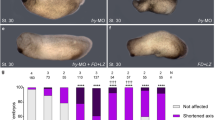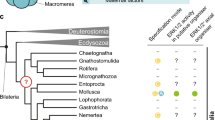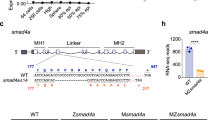Abstract
Bone morphogenetic proteins (BMPs), including the fly homologue Decapentaplegic (DPP), are important regulators of early vertebrate and invertebrate dorsal–ventral development1,2,3,4,5,6. An evolutionarily conserved BMP regulatory mechanism operates from fly to fish, frog and mouse to control the dorsal–ventral axis determination. Several secreted factors, including the BMP antagonist chordin/Short gastrulation (SOG)7,8,9,10,11,12, modulate the activity of BMPs. In Drosophila, Twisted gastrulation (TSG) is also involved in dorsal–ventral patterning13,14,15, yet the mechanism of its function is unclear. Here we report the characterization of the vertebrate Tsg homologues. We show that Tsg can block BMP function in Xenopus embryonic explants and inhibits several ventral markers in whole-frog embryos. Tsg binds directly to BMPs and forms a ternary complex with chordin and BMPs. Coexpression of Tsg with chordin leads to a more efficient inhibition of the BMP activity in ectodermal explants. Unlike other known BMP antagonists, however, Tsg also reduces several anterior markers at late developmental stages. Our data suggest that Tsg can function as a BMP inhibitor in Xenopus; furthermore, Tsg may have additional functions during frog embryogenesis.
This is a preview of subscription content, access via your institution
Access options
Subscribe to this journal
Receive 51 print issues and online access
$199.00 per year
only $3.90 per issue
Buy this article
- Purchase on Springer Link
- Instant access to full article PDF
Prices may be subject to local taxes which are calculated during checkout




Similar content being viewed by others
References
Irish, V. F. & Gelbart, W. M. The decapentaplegic gene is required for dorsal-ventral patterning of the Drosophila embryo. Genes Dev. 1, 868–879 (1987).
Ferguson, E. L. & Anderson, K. V. Decapentaplegic acts as a morphogen to organize dorsal-ventral pattern in the Drosophila embryo. Cell 71, 451–461 (1992).
Wharton, K. A., Ray, R. P. & Gelbart, W. M. An activity gradient of decapentaplegic is necessary for the specification of dorsal pattern elements in the Drosophila embryo. Development 117, 807–822 (1993).
Dale, L., Howes, G., Price, B. M. J. & Smith, J. C. Bone morphogenetic protein 4: a ventralizing factor in early Xenopus development. Development 115, 573–585 (1992).
Fainsod, A., Steinbeisser, H. & De Robertis, E. M. On the function of BMP-4 in patterning the marginal zone of the Xenopus embryos. EMBO J. 13, 5015–5025 (1994).
Jones, C. M., Dale, L., Hogan, B. L. M., Wright, C. V. E. & Smith, J. C. Bone morphogenetic protein-4 (BMP-4) acts during gastrula stages to cause ventralization of Xenopus embryos. Development 122, 1545–1554 (1996).
Ferguson, E. L. & Anderson, K. V. Localized enhancement and repression of the activity of the TGF-β family member, decapentaplegic, is necessary for dorsal-ventral pattern formation in the Drosophila embryo. Development 114, 583–597 (1992).
Francois, V., Solloway, M., O'Neill, J. W., Emery, J. & Bier, E. Dorsal-ventral patterning of the Drosophila embryo depends on a putative negative growth factor encoded by the short gastrulation gene. Genes Dev. 8, 2602–2616 (1994).
Biehs, B., Francois, V. & Bier, E. The Drosophila short gastrulation gene prevents Dpp from autoactivating and suppressing neurogenesis in the neuroectoderm. Genes Dev. 10, 2922–2934 (1996).
Holley, S. A. et al. A conversed system for dorsal-ventral patterning in insects and vertebrates involving sog and chordin. Nature 376, 249–253 (1995).
Schmidt, J., Francois, V., Bier, E. & Kimelman, D. Drosophila short gastrulation induces an ectopic axis in Xenopus: evidence for conserved mechanism of dorsal-ventral patterning. Development 121, 4319–4328 (1995).
Piccolo, S., Sasai, Y., Lu, B. & De Robertis, E. M. Dorsoventral patterning in Xenopus: inhibition of ventral signals by direct binding of chordin to BMP-4. Cell 86, 589–598 (1996).
Zusman, S. B. & Wieschaus, E. F. Requirements for zygotic gene activity during gastrulation in Drosophila melanogaster. Dev. Biol. 111, 359–371 (1985).
Mason, E. D., Konrad, K. D., Webb, C. D. & Marsh, J. L. Dorsal midline fate in Drosophila embryos requires twisted gastrulation, a gene encoding a secreted protein related to human connective tissue growth factor. Genes Dev. 8, 1489–1501 (1994).
Mason, E. D., Williams, S., Grotendorst, G. R. & Marsh, J. L. Combinatorial signaling by twisted gastrulation and decapentaplegic. Mech. Dev. 64, 61–75 (1997).
Wilson, P. A. & Hemmati-Brivanlou, A. Induction of epidermis and inhibition of neural fate by Bmp-4. Nature 376, 331–333 (1995).
Sasai, Y., Lu, B., Steinbeisser, H. & De Robertis, E. M. Regulation of neural induction by the Chd and Bmp-4 antagonistic patterning signals in Xenopus. Nature 376, 333–336 (1995).
Hawley, S. H. B. et al. Disruption of BMP signals in embryonic Xenopus ectoderm leads to direct neural induction. Genes Dev. 9, 2923–2935 (1995).
Hemmati-Brivanlou, A. & Thomsen, G. H. Ventral mesodermal patterning in Xenopus embryos: expression patterns and activities of BMP-2 and BMP-4. Dev. Genet. 17, 78–89 (1995).
Schultheiss, T. M., Burch, J. B. E. & Lassar, A. B. A role for bone morphogenetic proteins in the induction of cardiac myogenesis. Genes Dev. 11, 451–462 (1997).
Shi, Y., Katsev, S., Cai, C. & Evans, S. BMP signaling is required for heart formation in vertebrates. Dev. Biol. 224, 226–237 (2000).
Zimmerman, L. B., De Jesus-Escobar, J. M. & Harland, R. M. The Spemann organizer signal noggin binds and inactivates bone morphogenetic protein 4. Cell 86, 599–606 (1996).
Yu, K. et al. Processing of the Drosophila Sog protein creates a novel BMP inhibitory activity. Development 127, 2143–2154 (2000).
Scott, I. C. et al. Homologues of Twisted gastrulation are extracellular cofactors in antagonism of BMP signalling. Nature 410, 475–478 (2001).
Ross, J. J. et al. Twisted gastrulation is a conserved extracellular BMP antagonist. Nature 410, 479–483 (2001).
Oelgeschlager, M., Larrain, J., Geissert, D. & De Robertis, E. M. The evolutionarily conserved BMP-binding protein Twisted gastrulation promotes BMP signalling. Nature 405, 757–763 (2000).
Vesque, C. et al. Development of chick axial mesoderm: specification of precordal mesoderm by anterior endoderm-derived TGFβ family signalling. Development 127, 2795–2809 (2000).
Dale, J. K. et al. Cooperation of BMP7 and SHH in the induction of forebrain ventral midline cells by prechordal mesoderm. Cell 90, 257–269 (1997).
Hammerschmidt, M., Serbedzija, G. N. & McMahon, A. P. Genetic analysis of dorsoventral pattern formation in the zebrafish: requirement of a BMP-like ventralizing activity and its dorsal repressor. Genes Dev. 10, 2452–2461 (1996).
Chang, C. & Hemmati-Brivanlou, A. Xenopus GDF6, a new antagonist of noggin and a partner of BMPs. Development 126, 3347–3357 (1999).
Acknowledgements
We thank K. Lee and T. Jessell for providing the chick chordin construct; G. Struhl for providing the CD2 construct; A. Economides for technical advice on biochemical studies; and P. Wilson, D. Weinstein, E. Bell and I. Zohn for critical reading of the manuscript. We are grateful to M. O'Connor, K. Cho, L. Marsh and D. Greenspan for communicating their results before publication. This work is supported by an NIH grant to A.H.B., who is a McKnight, Merck and Klingenstein scholar.
Author information
Authors and Affiliations
Corresponding author
Rights and permissions
About this article
Cite this article
Chang, C., Holtzman, D., Chau, S. et al. Twisted gastrulation can function as a BMP antagonist. Nature 410, 483–487 (2001). https://doi.org/10.1038/35068583
Received:
Accepted:
Issue Date:
DOI: https://doi.org/10.1038/35068583
This article is cited by
-
Highly conserved and extremely evolvable: BMP signalling in secondary axis patterning of Cnidaria and Bilateria
Development Genes and Evolution (2024)
-
Recent developments on BMPs and their antagonists in inflammatory bowel diseases
Cell Death Discovery (2023)
-
Effect of corticision on orthodontic tooth movement in a rat model as assessed by RNA sequencing
Journal of Molecular Histology (2017)
-
Bone morphogenetic protein-4: a novel therapeutic target for pathological cardiac hypertrophy/heart failure
Heart Failure Reviews (2014)
-
Sirenomelia: a review on embryogenic enviromental theories, novel three-dimensional ultrasound imaging and first trimester diagnosis in a case of mosaic 69,XXX/46,XX fetus
Archives of Gynecology and Obstetrics (2013)
Comments
By submitting a comment you agree to abide by our Terms and Community Guidelines. If you find something abusive or that does not comply with our terms or guidelines please flag it as inappropriate.



